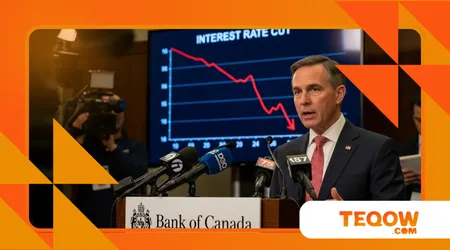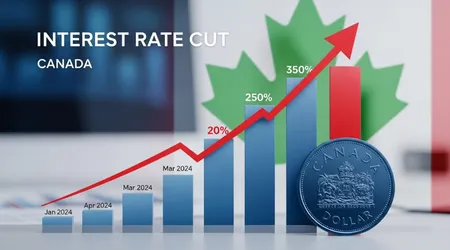How Recent Interest Rate Decisions by Bank of Canada Are Shaping the Economy

The Recent Interest Rate Decisions by Bank of Canada Are Shaping the Economy profoundly, dictating everything from housing affordability to the cost of business investment.
As of October 2025, the central bank’s recent move to cut its target for the overnight rate to $2.5\%$ marked a definitive pivot in monetary policy.
This shift signals a departure from the aggressive tightening cycle of previous years, prioritizing economic stimulus amidst mounting global trade headwinds and softening domestic growth.
After holding the line for several announcements, the Governing Council’s decision in September to reduce the policy rate by $25$ basis points confirmed a new ‘easing’ bias.
This strategic maneuver attempts to inject liquidity back into the Canadian economy, which has recently exhibited signs of strain.
Understanding these calculated changes is crucial for businesses and households trying to forecast their financial futures.
The ongoing impact of these Recent Interest Rate Decisions by Bank of Canada Are Shaping the Economy across multiple sectors remains a central focus for financial commentators.
Why Is the Bank of Canada Easing Rates Now? (The Economic Rationale)
The primary mandate of the Bank of Canada (BoC) is maintaining price stability, keeping inflation near the $2\%$ target, while supporting maximum sustainable employment.
Their recent actions reflect a complex calculus where the risks to growth have superseded the risks of persistent inflation.
H3: What Data Points Influenced the Bank’s Decision to Cut Rates?
A crucial factor driving the September rate cut was the moderation in the annual Consumer Price Index (CPI) inflation, which registered $1.9\%$ in August 2025.
This figure falls comfortably within the BoC’s target range of $1\%$ to $3\%$, providing the necessary space for monetary easing.
Core inflation measures, while higher at around $2.5\%$, showed signs of dissipating upward momentum on a monthly basis.
Furthermore, economic growth, or Gross Domestic Product (GDP), has weakened significantly, with the second quarter of 2025 posting a recessionary contraction.
This subdued economic activity, coupled with global trade uncertainty particularly the impact of escalating tariffs justified a proactive cut. The BoC explicitly noted it needs to better balance inflation and growth risks moving forward.
The trade environment, including the unpredictable nature of US trade policy, creates profound uncertainty, dampening business investment intentions.
By reducing the cost of borrowing, the Bank hopes to counteract these external drags, making capital projects more viable domestically.
++ Canada’s Response to Climate Objectives: Key Legislation & Environmental Initiatives
How Do Global Trade Risks Factor Into Domestic Interest Rates?
The threat of higher, unpredictable international tariffs fundamentally reshapes Canadian economic prospects.
Tariffs act as a tax, increasing import costs (which is inflationary) but simultaneously reducing demand for Canadian exports (which is disinflationary/deflationary). The BoC must weigh these opposing forces.
The Governing Council judged the overall effect of tariffs and trade tensions would ultimately weigh down economic activity more than they would drive up consumer prices.
Therefore, the rate cut acts as an insurance policy against a deepening domestic slowdown triggered by external trade shocks.
These external pressures highlight how the Recent Interest Rate Decisions by Bank of Canada Are Shaping the Economy in response to global instability.

What Effect Are Lower Rates Having on the Housing Market and Debt?
The housing market, notoriously sensitive to borrowing costs, reacts immediately to changes in the policy rate.
Lower rates translate directly into reduced mortgage interest payments, providing immediate financial relief for many Canadians.
Also read: Breaking Down Canada’s Latest Immigration Policy Changes & What They Mean for Aspirants
How Is the Rate Cut Impacting Mortgage Holders and Buyers?
Current variable-rate mortgage holders experience instant relief as their payments decrease, freeing up household disposable income.
This is a critical respite for over-leveraged households. For new homebuyers, a lower prime rate translates to lower costs for both fixed and variable rate mortgages, increasing purchasing power.
A homeowner with a $\$400,000$ variable-rate mortgage saw their interest expense immediately drop, perhaps saving them $\$50$ to $\$80$ per month.
While seemingly small, this creates psychological confidence and real fiscal room for families. The cumulative effect of these Recent Interest Rate Decisions by Bank of Canada Are Shaping the Economy is vast.
The reduction in mortgage qualification criteria also eases entry for first-time buyers, stimulating demand.
The market is recovering; August 2025 saw Canada’s housing market post its strongest August performance since 2021, a trend likely to accelerate with lower rates.
What is the Implication for Household and Corporate Debt Management?
Lower interest rates make carrying existing debt cheaper, which is vital given the high levels of household indebtedness in Canada.
This allows families to service debts more easily, reducing the risk of loan defaults that could destabilize the financial system.
For businesses, the reduced cost of corporate debt makes expansion and refinancing more attractive. Companies previously postponing large capital expenditures due to high borrowing costs may now greenlight those projects, stimulating job creation and productivity.
This is where the BoC translates monetary policy into tangible economic activity. A reduction in rates essentially acts as a gentle tailwind for debt-burdened sectors, helping them sail forward rather than flounder against the current.
The ability of the Recent Interest Rate Decisions by Bank of Canada Are Shaping the Economy is particularly acute in these highly-leveraged areas.
What Risks Does the BoC Face with Continued Easing?
While the current economic data supports the easing cycle, central banking is fundamentally about managing future expectations and risks.
The BoC must navigate a path where the rate cuts stabilize growth without reigniting inflationary pressures.
Could Rate Cuts Lead to a Resurgence in Inflation?
The key risk remains the possibility of re-accelerated inflation, particularly if the US economy proves stronger than anticipated or if global supply chains react unexpectedly to trade tensions.
A sudden spike in commodity prices or a sharp depreciation of the Canadian dollar could quickly push CPI back above the $2\%$ target.
The shelter component of CPI, driven by mortgage interest costs and rents, remains persistently high, exceeding $4\%$ in recent data.
Although the rate cut directly lowers mortgage interest costs, the general stimulus could indirectly drive up demand for housing, potentially pushing house prices and rents higher. This creates a difficult policy conundrum for the Bank.
The Bank of Canada is essentially walking a tightrope. One side is the chasm of recession (too high rates, choking growth), and the other is the chasm of inflation (too low rates, overheating the economy).
The recent rate cut is a subtle shift of balance, compensating for the strong headwind of trade uncertainty.
How Does Policy Divergence from the US Impact the Canadian Dollar?
The interest rate differential between Canada and the United States has widened as the BoC cuts rates while the U.S. Federal Reserve adopts a more cautious stance.
This policy divergence places downward pressure on the Canadian dollar ($CAD$). A weaker $CAD$ makes Canadian exports cheaper for foreign buyers, supporting trade-exposed sectors, but also makes imports including consumer goods more expensive.
This ‘imported inflation’ is a secondary risk that the BoC must closely monitor. Chart 1 in the Bank of Canada’s February 2025 analytical note explicitly showed the widening gap between US and Canadian policy rates, an economic reality which influences foreign exchange markets.
The Recent Interest Rate Decisions by Bank of Canada Are Shaping the Economy and its currency’s valuation against the USD.
Sectoral and Market Impact: Who Wins and Who Loses?
Different sectors of the economy experience the effects of lower interest rates unevenly. The cuts create clear winners and losers.
Which Sectors Benefit the Most from Lower Rates?
The housing and real estate sector benefits most directly. Builders and developers face lower construction financing costs, and demand for properties increases.
Rate-sensitive cyclicals, such as manufacturing and technology, see a direct boost as the cost of expanding operations or acquiring new equipment drops.
Financial institutions, specifically banks, see mixed effects. While reduced mortgage interest revenue can hurt the short term, the lower risk of loan defaults due to reduced household stress is a significant long-term benefit for balance sheet stability.
The $CAD$ weakness benefits resource-exporting sectors, such as oil and gas, forestry, and mining, as their US dollar-denominated revenues are worth more when converted back to Canadian dollars.
These sectors are critical beneficiaries as the Recent Interest Rate Decisions by Bank of Canada Are Shaping the Economy.
Which Components of the Economy Face the Greatest Headwinds?
Savers relying on fixed-income investments, such as Guaranteed Investment Certificates (GICs) and savings accounts, suffer from reduced returns.
Pension funds and insurance companies must adjust their investment strategies to generate adequate returns in a lower-rate environment.
Furthermore, any sector heavily dependent on imported components, such as automotive assembly, will face higher input costs due to the weaker Canadian dollar.
This can squeeze profit margins unless they can pass those costs on to consumers.
The overall environment, however, suggests the BoC is prioritizing the broad-based stability of the economy over the returns for savers, a difficult but necessary policy trade-off. Can any responsible central bank ignore such a significant downturn risk?
Key Economic Indicators: August 2025 Snapshot
The Bank of Canada based its September $17$ decision on these key figures, revealing the necessary trade-off between inflation control and economic growth:
| Indicator | August 2025 Data | BoC Target/Benchmark | Implication for Rate Cut |
| CPI Inflation (YoY) | $1.9\%$ | $2.0\%$ (Midpoint) | Met Target: Provides room to cut. |
| GDP Growth (Q2 2025) | $-1.6\%$ (Annualized) | $1.5\%$ to $2.0\%$ (Typical) | Weak: Pressures BoC to stimulate growth. |
| Core Inflation (CPI-Median) | $3.1\%$ | $1.0\%$ to $3.0\%$ (Range) | High: Requires careful future monitoring. |
The August 2025 CPI data, confirming inflation near target, was the green light for the BoC to focus on the contractionary GDP.
Conclusion: A Delicate Balancing Act Continues
The Recent Interest Rate Decisions by Bank of Canada Are Shaping the Economy by aggressively steering it away from a deeper slowdown caused by global trade turbulence.
The September rate cut to $2.5\%$ marks a decisive shift towards easing, offering welcome relief to mortgage holders and a necessary stimulus for business investment.
The immediate challenge now shifts to preventing an inflationary re-acceleration, particularly in the persistently hot housing component.
The Bank of Canada must remain vigilant, ready to pause or reverse course if the economic winds shift. The next scheduled announcement on October $29$ is therefore highly anticipated, with markets closely watching for further cuts.
The fate of Canada’s economic recovery rests on the precision of this monetary policy.
Share your experience and strategies on how the $2.5\%$ rate is affecting your personal or business finances in the comments below.
Frequently Asked Questions (FAQ)
What is the Bank of Canada’s target for the overnight rate right now?
As of the September $17$, 2025 announcement, the Bank of Canada’s target for the overnight rate is $2.5\%$. This rate dictates the prime lending rates set by commercial banks.
Will the BoC cut rates again before the end of 2025?
Market odds for the upcoming October $29$ decision suggest a high probability (around $66\%$) of a further cut to $2.25\%$.
Future decisions are highly data-dependent, contingent on whether GDP stabilizes and inflation remains under control.
What is the “policy divergence” I keep hearing about?
Policy divergence refers to the Bank of Canada lowering its interest rates while the US Federal Reserve keeps its rates steady or higher.
This creates a yield differential, typically leading to a weaker Canadian dollar ($CAD$) against the US dollar ($USD$).
How do interest rate cuts affect the stock market?
Generally, lower rates are viewed positively by the stock market. They reduce the borrowing costs for companies, increasing corporate profits, and make bonds less attractive, pushing investors towards higher-risk, potentially higher-return equities.
The rate cuts specifically benefit rate-sensitive sectors like real estate and financials.
